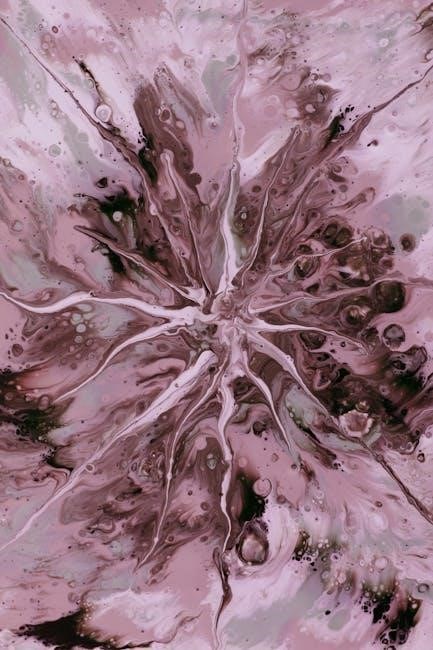Paint booth design is crucial for efficient and safe industrial painting processes, ensuring proper airflow, overspray control, and adherence to safety standards for optimal finishing results.
1.1 Importance of Proper Paint Booth Design
Proper paint booth design is essential for ensuring safety, efficiency, and high-quality finishing in industrial painting processes. It prevents overspray, maintains consistent airflow, and adheres to safety standards, reducing fire hazards and contamination risks. A well-designed booth optimizes energy use, minimizes waste, and enhances worker productivity. Incorrect designs can lead to poor air quality, uneven coatings, and compliance issues. Prioritizing proper design ensures a controlled environment, meeting regulatory requirements while delivering superior paint application results consistently.
1.2 Overview of Paint Booth Types
Paint booths are categorized into five primary types: Cross Flow, Side Down Draft, Semi Down Draft, Full Down Draft, and Open Face Industrial Booths. Each type is designed to optimize airflow patterns and overspray removal, ensuring efficient painting processes. Cross Flow booths intake air through the front and exhaust through the back, while Side Down Draft booths direct air from the sides downward. Semi and Full Down Draft booths utilize airflow from the ceiling to the floor, offering superior contamination control. Open Face Industrial Booths are ideal for large-scale applications, providing accessibility and flexibility in industrial settings.

Key Components of a Paint Booth
A paint booth’s key components include walls, doors, air intake plenum, exhaust chamber, and AMU, ensuring proper airflow, overspray control, and adherence to safety standards.
2.1 Paint Booth Walls and Doors
Paint booth walls and doors are critical components designed to ensure smooth airflow and prevent overspray contamination. Constructed from durable materials, they maintain structural integrity while supporting airflow patterns specific to booth types like cross flow or side down draft. Proper sealing is essential to prevent air leaks and maintain consistent pressure. Doors are typically designed for easy access and may include features like windows for visibility. Compliance with safety standards ensures fire resistance and proper ventilation, making walls and doors vital for safe and efficient painting operations.
2.2 Air Intake Plenum and Exhaust Chamber
The air intake plenum and exhaust chamber are essential for maintaining optimal airflow within the paint booth. The intake plenum distributes filtered air evenly, ensuring a clean painting environment, while the exhaust chamber removes overspray and fumes. Properly designed, these components prevent contamination and maintain consistent air pressure. They work in tandem with the AMU to regulate airflow patterns, such as cross flow or downdraft systems. Their efficiency directly impacts paint quality and safety, adhering to CFM requirements and ventilation standards to minimize hazards and ensure a smooth finishing process.
2.3 Air Make-Up Unit (AMU)
The Air Make-Up Unit (AMU) is a critical component in paint booth design, responsible for replenishing air lost through the exhaust system. It ensures consistent airflow by introducing heated or filtered air, maintaining optimal temperature and humidity levels. The AMU also compensates for air pressure changes, preventing vacuum effects. Modern AMUs are designed for energy efficiency, reducing operational costs. Proper integration with the booth’s HVAC system ensures precise climate control, which is vital for paint curing and finish quality. Regular maintenance of the AMU is essential to sustain airflow patterns and overall booth performance.

Types of Paint Booths
Paint booths are categorized into Cross Flow, Side Down Draft, Semi Down Draft, Full Down Draft, and Open Face Industrial Booths, each designed for specific applications and airflow patterns to optimize painting efficiency and quality.
3.1 Cross Flow Paint Booths
Cross Flow Paint Booths are designed with airflow entering through the front doors and exiting through the back, creating a clean environment for painting. They use intake filters at the entrance and exhaust filters at the back to maintain air quality. This design is ideal for automotive and small industrial applications due to its simplicity and cost-effectiveness. The airflow pattern minimizes overspray and ensures a smooth finish. These booths are often preferred for their ease of installation and maintenance, making them a popular choice for businesses needing reliable painting solutions. Proper filter maintenance is essential for optimal performance.
3.2 Side Down Draft Paint Booths
Side Down Draft Paint Booths feature airflow entering through side panels and exiting downward, creating a vertical flow pattern. This design is effective for painting large or irregularly shaped objects, as it minimizes overspray and contamination. The side intake ensures clean air circulation around the workpiece, enhancing finish quality. These booths are commonly used in aerospace and industrial applications where precise control over paint application is critical. Regular maintenance of filters and exhaust systems is essential to maintain optimal performance and safety standards in these configurations.
3.3 Semi Down Draft Paint Booths
Semi Down Draft Paint Booths combine elements of cross flow and downdraft systems, featuring a rear intake and partial downdraft exhaust. This hybrid design provides excellent overspray control and a balanced airflow pattern, reducing contamination risks. Ideal for applications requiring precise finishing, these booths are widely used in automotive and industrial settings. Their versatility allows for efficient painting of various part sizes, while maintaining a clean working environment. Regular filter maintenance and proper exhaust management are crucial to ensure optimal performance and safety in Semi Down Draft configurations.
3.4 Full Down Draft Paint Booths
Full Down Draft Paint Booths utilize a vertical airflow pattern, drawing air from the ceiling and exhausting it through the floor. This design minimizes overspray and contamination by moving particles downward, away from the workpiece. Ideal for large or irregularly shaped objects, these booths provide superior airflow control and cleanliness. They are commonly used in high-end industrial and automotive applications where precision finishing is critical. The grated floor design allows for easy cleanup, and the heavy-duty exhaust system ensures efficient operation, making Full Down Draft booths a preferred choice for demanding painting environments.
3.5 Open Face Industrial Booths
Open Face Industrial Booths are designed for large-scale painting operations, featuring an open front for easy access to oversized or irregularly shaped items. These booths rely on powerful airflow systems to contain overspray and ensure a clean painting environment. Ideal for industrial settings, they are often used in factories or plants where space is limited. The open design allows for flexibility, while the robust ventilation system maintains air quality and safety standards. This booth type is a practical solution for high-volume production and specialized coating applications.

Booth Sizing and Layout
Booth sizing and layout are determined by the largest item to be painted, with additional space for painter maneuverability, ensuring efficient workflow and optimal painting conditions.
4.1 Determining Booth Size Based on Application
Booth size is determined by the largest item to be painted, with a minimum of 3 feet of clearance on each side for painter maneuverability. Custom booths can accommodate unique or oversized parts, while standard sizes are suitable for common applications. Proper sizing ensures efficient workflow, optimal airflow, and adherence to safety standards. Measuring the part accurately and accounting for additional space ensures the booth meets application-specific needs, balancing functionality and cost-effectiveness for various industrial or automotive painting requirements.
4.2 Custom vs. Standard Booth Designs
Choosing between custom and standard booth designs depends on specific application needs. Custom booths offer tailored solutions for unique or oversized parts, ensuring precise fitment and functionality. Standard booths provide cost-effective, pre-engineered options for common applications, balancing efficiency and affordability. Custom designs allow for specialized features, while standard booths meet typical requirements with proven reliability. The decision often hinges on part size, budget, and lead time, with custom booths addressing complex needs and standard booths serving straightforward applications effectively.

Airflow Requirements
Airflow is essential for maintaining a clean environment, ensuring proper ventilation, and preventing contamination during painting. It directly impacts finish quality and safety, requiring precise calculations and balanced patterns.

5.1 CFM (Cubic Feet per Minute) Calculations
CFM calculations are critical for determining the airflow required in a paint booth. The formula typically involves the booth’s dimensions and the desired airflow velocity. For small booths, 200 CFM per square foot of open cross-section is recommended for areas up to 4 square feet, while 150 CFM is suitable for larger areas. For walk-in booths, 100 CFM per square foot is standard, reducing to 75 CFM for deeper booths. Accurate CFM ensures proper ventilation, overspray control, and compliance with safety standards. Always consult local regulations for specific requirements.
5.2 Airflow Patterns for Different Booth Types
Airflow patterns vary significantly across paint booth types, impacting efficiency and finish quality. Cross flow booths direct air horizontally, reducing overspray but requiring precise filter placement. Side down draft booths pull air from the sides, minimizing turbulence and enhancing particle removal. Semi and full down draft booths channel air vertically, reducing dust and contaminants for high-quality finishes. Open face booths rely on natural airflow, making them less controlled but cost-effective; Each design ensures optimal paint adhesion and safety by maintaining a clean environment and preventing contamination. Proper airflow alignment is critical for achieving desired results.

Safety Standards and Regulations
Safety standards are essential to prevent fire hazards and ensure proper ventilation. Regulations focus on explosion prevention, airflow control, and maintaining a safe painting environment for operators.
6.1 Fire Safety and Explosion Prevention
Fire safety and explosion prevention are critical in paint booth design. Proper ventilation systems must be installed to remove flammable vapors and overspray, reducing the risk of ignition. Fire-resistant materials should be used for booth construction to prevent rapid fire spread. Explosion-proof lighting and electrical components are essential to minimize ignition sources. Regular inspections and maintenance of ventilation systems ensure compliance with safety standards. Fire suppression systems should also be integrated to quickly address any potential fires. Adherence to OSHA and NFPA regulations is mandatory to safeguard personnel and equipment.
6.2 Ventilation and Air Quality Standards
Proper ventilation is essential for maintaining air quality in paint booths, ensuring a safe working environment and optimal painting conditions. Booths must meet OSHA and NFPA standards for airflow rates, typically requiring 100 CFM per square foot for large booths and 150-200 CFM per square foot for smaller ones. Airflow patterns, such as cross flow or downdraft, must be designed to prevent overspray contamination and remove hazardous fumes. Regular maintenance of filters and ventilation systems is critical to uphold air quality and prevent the accumulation of flammable vapors, ensuring compliance with safety regulations and promoting worker health.

Advanced Paint Booth Technology
Modern paint booths incorporate energy-efficient designs, smart airflow controls, and advanced filtration systems, enhancing productivity while reducing environmental impact and operational costs.
7.1 Energy-Efficient Design Features
Energy-efficient paint booths incorporate LED lighting, advanced filtration systems, and heat recovery units to minimize energy consumption. These designs reduce operational costs while maintaining optimal performance. Variable-speed controls optimize airflow, lowering electricity usage. Smart technologies, such as automated shutdowns and sensors, further enhance efficiency. These features not only reduce environmental impact but also improve workplace safety and productivity, making them a sustainable choice for modern industrial applications. Energy-efficient booths are increasingly popular as industries prioritize cost-saving and eco-friendly solutions without compromising on quality or functionality.
7.2 Integration with Industrial Automation Systems
Modern paint booths integrate seamlessly with industrial automation systems, enhancing efficiency and consistency. Advanced automation technologies, such as variable-speed controls and smart sensors, optimize airflow and temperature. These systems enable real-time monitoring and control, ensuring precise paint application and reduced waste. Integration with SCADA systems allows for centralized management, while automation reduces manual intervention, improving safety. GFS technology and automated filtration systems further enhance performance. This synergy between booth design and industrial automation ensures streamlined operations, higher productivity, and adherence to quality standards, making it a cornerstone of advanced manufacturing processes.

Maintenance and Upkeep
Regular maintenance ensures optimal paint booth performance, safety, and longevity. Key tasks include cleaning filters, inspecting airflow systems, and ensuring all components function as intended.
8.1 Regular Maintenance Schedule
A well-planned maintenance schedule is vital for paint booth efficiency and safety. Daily tasks include cleaning filters and inspecting airflow systems. Weekly checks involve examining exhaust fans and ensuring proper ventilation. Monthly maintenance should cover replacing worn-out filters, checking electrical connections, and verifying the functionality of safety devices. Seasonal inspections focus on ductwork cleanliness and ensuring compliance with safety standards. Adhering to this schedule prevents downtime, optimizes painting results, and prolongs the booth’s lifespan while maintaining a safe working environment for operators.
8.2 Troubleshooting Common Issues
Identifying and resolving issues promptly is essential for maintaining paint booth performance. Common problems include poor airflow, clogged filters, and electrical malfunctions. Regularly inspect filters and replace them as needed to ensure proper ventilation. Check for blockages in ductwork and verify that exhaust fans are functioning correctly. Addressing overspray buildup on walls and doors can prevent contamination. Electrical issues should be investigated by certified professionals to ensure safety. By troubleshooting these common problems, operators can maintain efficiency, reduce downtime, and ensure a safe working environment while achieving high-quality paint finishes consistently.

Case Studies and Real-World Applications
Real-world applications highlight how custom paint booths solve industrial challenges, from automotive to aerospace, ensuring efficiency and quality. GFS booths are tailored for specific industry needs, delivering optimal results.
9.1 Industrial Paint Booth Installations
Industrial paint booth installations are tailored to meet specific manufacturing needs, ensuring efficient finishing processes. GFS booths, for instance, are designed to handle large equipment, providing optimal airflow and safety. These installations often feature advanced filtration systems to minimize overspray and contamination, while adhering to strict safety standards. Customized solutions allow businesses to streamline production, reduce downtime, and improve product quality. Real-world applications demonstrate how these booths enhance operational efficiency and productivity in various industries, from automotive to aerospace.
9.2 Custom Paint Booth Solutions for Specific Industries
Custom paint booth solutions are designed to meet the unique needs of specific industries, ensuring optimal performance and compliance with industry standards. For aerospace, booths may feature advanced filtration systems to handle specialized coatings. Automotive manufacturers often require large-scale booths with high airflow rates to accommodate vehicle painting. In contrast, smaller industries like furniture finishing may benefit from compact, energy-efficient designs. These tailored solutions enhance productivity, improve finish quality, and adapt to the precise requirements of each sector, making them indispensable for modern manufacturing processes and specialized applications.
